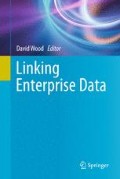Abstract
Business Process Management Systems (BPMS) are a component of the stack of Web standards that comprise Service Oriented Architecture (SOA). Such systems are representative of the architectural framework of modern information systems built in an enterprise intranet and are in contrast to systems built for deployment on the larger World Wide Web. The REST architectural style is an emerging style for building loosely coupled systems based purely on the native HTTP protocol. It is a coordinated set of architectural constraints with a goal to minimize latency, maximize the independence and scalability of distributed components, and facilitate the use of intermediary processors.Within the development community for distributed, Web-based systems, there has been a debate regarding themerits of both approaches. In some cases, there are legitimate concerns about the differences in both architectural styles. In other cases, the contention seems to be based on concerns that are marginal at best. In this chapter, we will attempt to contribute to this debate by focusing on a specific, deployed use case that emphasizes the role of the Semantic Web, a simple Web application architecture that leverages the use of declarative XML processing, and the needs of a workflow system. The use case involves orchestrating a work process associated with the data entry of structured patient record content into a research registry at the Cleveland Clinic’s Clinical Investigation department in the Heart and Vascular Institute.
Access this chapter
Tax calculation will be finalised at checkout
Purchases are for personal use only
Preview
Unable to display preview. Download preview PDF.
References
Berners-Lee T, Hendler J, Lassila O: The Semantic Web. Scientific American 284(5):34–43, 2001.
Bizer C, Heath T, Berners-Lee T:Linked Data–The Story So Far. International Journal on Semantic Web and Information Systems 5(3):1–22, 2009.
Connolly C: Gleaning Resource Descriptions from Dialects of Languages (GRDDL). W3C Candidate Recommendation, 2007.
Decker S, Melnik S, Van Harmelen F, Fensel D, Klein M, Broekstra J, Erdmann M, Horrocks I. The Semantic Web: The roles of XML and RDF. IEEE Internet computing 4(5):63–73, 2000.
Eder J (2009) Workflow Management and Workflow Management System. In Ling L, Tamer O (eds) Encyclopedia of Database Systems.
Fielding R, Gettys J, Mogul J, Frystyk H,Masinter L, Leach P, and Berners-Lee T. RFC2616: Hypertext Transfer Protocol–HTTP/1.1. RFC Editor United States, 1999.
Fielding R. Representational State Transfer (REST). Chapter 5 in Architectural Styles and the Design of Network–based Software Architectures. Ph. D. Thesis, University of California, Irvine, CA, 2000.
Hayes P. RDF Model Theory. Technical report, W3C Recommendation, February 2004.
Hayes P, and Halpin H. In Defense of Ambiguity. International Journal on Semantic Web and Information Systems 4(2):1–18, 2008.
Huynh D, Karger D, and Miller R. Exhibit: Lightweight Structured Data Publishing. In Proceedings of the 16th international conference on World Wide Web, page 746. ACM, 2007.
Kindberg T, Hawke S. The tag URI Scheme. 2005.
Lloyd J. Practical Advantages of Declarative Programming. In Joint Conference on Declarative Programming, GULP-PRODE, volume 94, 1994.
Mankovski S (2009) Service Oriented Architecture. In Ling L, Tamer O (eds) Encyclopedia of Database Systems.
Ogbuji C (2009) Clinical Data Acquisition, Storage and Management. In Ling L, Tamer O (eds) Encyclopedia of Database Systems.
Ogbuji U, Ogbuji C. Develop Python/XML with 4Suite, Part 5: The Repository Features. http://www.ibm.com/developerworks/edu/x-dw-x4suite5-i.html, 2002.
Olsen L, Aisner D, and McGinnis J. The Learning Healthcare System: Workshop Summary. Natl Academy Pr, 2007.
Pautasso C, Wilde E. Why is the Web Loosely Coupled?: A Multi-faceted Metric for Service Design. In Proceedings of the 18th international conference on World Wide Web, pages 911–920. ACM, 2009.
Pautasso C, Zimmermann O, Leymann F. RestfulWeb Services vs. BigWeb Services:Making the Right Architectural Decision. In Proceeding of the 17th international conference onWorld Wide Web, pages 805–814. ACM, 2008.
Thompson H. Web Architecture and Naming for Knowledge Resources. Large-Scale Knowledge Resources. Construction and Application, pages 334–343.
Wil P, van der A (2009) Business Process Execution Language. In Ling L, Tamer O (eds) Encyclopedia of Database Systems.
Vinoski S. Putting the Web into Web Services: Interaction Models, Part 2. IEEE Internet Computing 6(4):90–92, 2002.
Vinoski S. Serendipitous Reuse. Distributed Systems Online, 2008.
Wohlstadter E (2009) SOAP. In Ling L, Tamer O (eds) Encyclopedia of Database Systems
Author information
Authors and Affiliations
Corresponding author
Editor information
Editors and Affiliations
Rights and permissions
Copyright information
© 2010 Springer Science+Business Media, LLC
About this chapter
Cite this chapter
Ogbuji, C. (2010). A Role for Semantic Web Technologies in Patient Record Data Collection. In: Wood, D. (eds) Linking Enterprise Data. Springer, Boston, MA. https://doi.org/10.1007/978-1-4419-7665-9_12
Download citation
DOI: https://doi.org/10.1007/978-1-4419-7665-9_12
Published:
Publisher Name: Springer, Boston, MA
Print ISBN: 978-1-4419-7664-2
Online ISBN: 978-1-4419-7665-9
eBook Packages: Computer ScienceComputer Science (R0)

